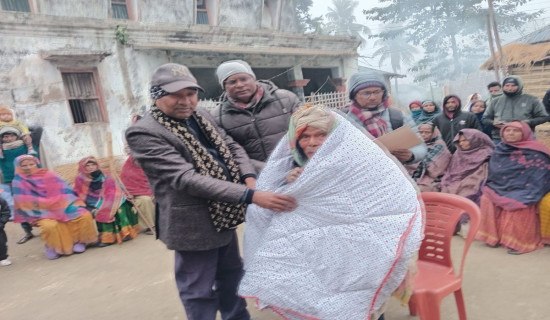- Wednesday, 7 January 2026
Remodel Public Transport System
Naturally, every passenger aspires to experience a safe, comfortable, affordable and hassle-free journey on both short- and long-routes. There is no doubt that Nepal has come a long way in terms of expanding road networks nationwide over the past some decades. Roads in several major cities have witnessed a significant rise in the number of comfortable modern public vehicles. The operation of such vehicles has brought cheers to passengers because of improved road safety and well-being.
Road casualties
However, passengers have continued to hit a snag with their trips. That nearly 3,000 people lose their lives in road accidents in the country annually is a bitter story to tell about. The figures released by the Nepal Police some months ago have shown that as many as seven persons die on roads daily. Motorcycle riders are more probable to die on roads than motorists. Thousands of others suffer serious injuries. Even pedestrians are often found getting maimed or killed after they are hit by vehicles. The data on road casualties is quite alarming. Many are bound to go through unbearable pains and utter hardships throughout their life due to the loss of their body organs while others face one or the other mental trauma. This directly affects their personal and family income as the injured lots are less likely to be able to work.
Last week, a scooter rider was crushed to death at Gatthaghar of Bhaktapur after a cargo truck hit him on the road. The area turned tense immediately after the accident. This is just a representative road disaster. However, the Ministry of Home Affairs (MoHA) has formed a committee to probe into the crash. Such unpredictable incidents seem to be taking place everywhere. Careless driving and overspeed are the key reasons for such mishaps. Although the traffic police offices often carry out campaigns for improving road safety across the nation, road accidents appear to be rampant, killing many lives. Vehicles are found meeting with accidents owing to their failure to abide by rules.
A bad condition of roads is equally responsible for increasing the number of vehicular mishaps. In Nepal, roads are hardly repaired and maintained on a regular basis, causing crashes. The authorities concerned and contractors are frequently found blaming each other for a delay in the maintenance of roads. And vehicles are forced to ply such roads. Transport entrepreneurs hold poor-quality roads accountable for fatal accidents taking place time and again. Their logic sounds genuine. But they are also responsible for road accidents, to a great extent, as they operate old and rickety vehicles. Another matter of concern is that they are least bothered about getting their vehicles repaired. Due to mechanical errors, vehicular accidents occur time and again.
The vehicles operating in the hilly and mountain regions often report break failures and emergence of problems with engines and other vital parts, leading to deadly accidents. A difficult topography and geological issues are also leading causes of road accidents in the country. A couple of weeks ago, two bus mishaps took place in the Simaltar area along the Narayanghat-Mugling road section in Chitwan district. Two buses coming from the opposite directions plunged into the flooded Trishuli River due to mudslides. The buses were carrying more than 65 passengers and crew members. However, three of them were successful in saving their lives by swimming.
One bus was on the way to Gaur of Rautahat district from Kathmandu while the other was heading to Kathmandu from Birgunj. Though extensive search and rescue operations were carried out, the whereabouts of the missing buses and passengers have not been known as yet. The unfortunate accident occurred since the crew members and passengers did not know about the possible natural disaster (mudslide) there. Had an early warming system been installed there, the tragic road disaster would have been prevented.
The taskforce that was formed to investigate the Simaltar accident recently submitted its report to the MoHA. As recommended by the taskforce, the ministry has now instructed the transport entrepreneurs to install GPS tracking systems and other devices in all vehicles to limit their speed. It has also asked them to conduct regular vehicle maintenance and inspections, phase out hoary and unfit vehicles, and install CCTV cameras and transponders in vehicles to ensure road safety.
In addition, the taskforce has suggested that drivers should receive regular training on safe driving practices and strictly follow traffic rules. Drunk driving is also a major reason for repeated road disasters. Therefore, in line with the taskforce’s suggestion, the ministry has called on transport operators to work towards preventing drunk driving. Besides, the ministry has directed the transport operators to hire two drivers for long routes so that they can drive the vehicle by turn. Road mishaps may occur when a single driver has to work long hours continuously as he becomes tired and feels sleepy.
Joint efforts in need
The government must implement the taskforce’s recommendations rigorously to address numerous issues, including third-party insurance. It must work together with the transport entrepreneurs to impart training and orientation to drivers and helpers in order to bring about desired changes in their attitudes and behaviours. Passengers face a lot of inconvenience due to hassles created by vehicle crew members. There are complaints that drivers and helpers overcharge and misbehave with passengers even in the Kathmandu Valley. Even the people living with disabilities, children, elderlies and pregnant women do not get seats while travelling by public vehicles. These vehicles are so unreliable that one cannot get to his/her destination on time as they stop wherever they like to collect more passengers. So, the government, political parties and transport operators must make joint efforts to reshape such a poor public transportation system without delay.
(The author is a former deputy executive editor of this daily.)

















